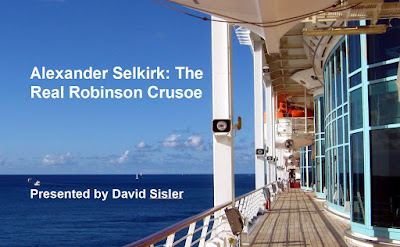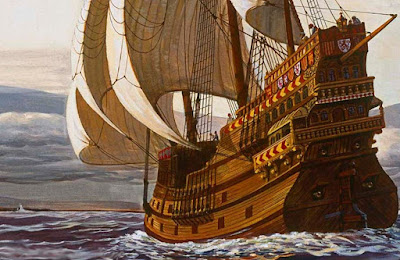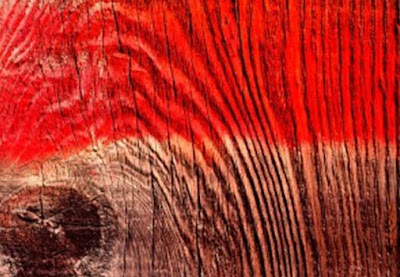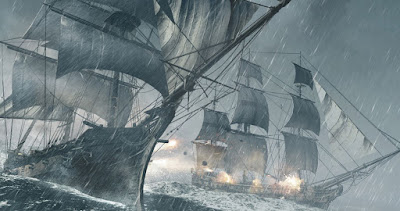May 22, 2021
On May 22, 1976 at eleven minutes after midnight, we welcomed our son, Michael David, to the family. It was also at that time that the doctor said, “Oh! There’s another baby in there!” That’s right – we had no idea. Forty-five years ago ultrasound was not an ordinary tool in prenatal care. And at 12:15 a.m. we greeted Michael’s womb mate, Matthew James. Happy birthday sons! What a joy you are!
👉 The QB erroneously said yesterday that Superman will continue today. Alas, the Man of Steel is in his Fortress of Solitude, and will not return until Monday.
The Duke and Duchess Arrive
On January 31, 1709, from his high lookout Selkirk watched the two ships enter the bay. He saw their flags through his spyglass: English!
He ran down the slope, through the woods, and waved frantically. A boat was lowered. As it neared shore, he heard English voices, saw English faces. Eight men waded ashore.
He was a strange sight – clothed in goatskins, beard hanging to his waist, managing only to grunt and mutter words that sounded like “marooned ... marooned.”
“At his first coming on board us,” Captain Woodes Rogers commented, “he had so much forgot his language for want of use, that we could scarce understand him.”
Noting Selkirk’s clothing of goatskin, Rogers said, “He looked wilder than the first owners of them.”
One of the officers, William Dampier, recognized Selkirk – “the best man on the Cinque Ports,” he stated.
Rogers had other problems than the castaway. Nearly half the 225 men on the two ships were ill with scurvy.
The sick men were lowered over the side into boats. Selkirk, in a frenzy of gratitude for being rescued, made known to Rogers that he would go ashore and help care for the sick men.
With Selkirk supervising a menu of roasted goat, and broth made from fresh greens, Rogers’ men began gaining strength within three days.
Within days, Selkirk’s ability to speak returned, and he and Rogers talked.
Woodes Rogers commanded the Duke and the Duchess, two privateers. Unlike most captains, he respected his crew and treated them courteously. Each day he held Church of England services on the quarterdeck.
Rogers intended to attack Spanish ships along the coast of South America. His plan was much like Stradling’s nearly 52 months earlier: to be in position off Mexico by November, to intercept the grandest prize of all, the Manila galleon, the Spanish empire’s treasure ship.
The Duke and Duchess were careened and repaired.
Selkirk helped supply the ships with fresh food. He led a work party to gather turnips, radishes, cabbages, and plums, and he pointed out the best places for fishing.
As a final detail, Rogers ordered the deck painted red, a customary practice in those days. The paint was carried from their home port. In battle, blood spilled on the deck would not be so visible.
Learning that Selkirk had been sailing master of the Cinque Ports and a veteran seaman, Rogers appointed him second mate of the Duke.
The Duke and Duchess raised anchor and sailed on February 14. The former castaway looked back on his island home. 52 months he had survived alone. By evening the island had slid below the horizon.
The Cinque Ports and the Manila Galleon
On March 16, 1709, the Duke and Duchess came upon their first prize, a small trading vessel. The threat of the Duke’s open gun ports was enough to lower its sails.
The master, Antonio Heliagos, was brought on board the Duke. Amazingly, he had unexpected news about Thomas Stradling and the crew of the Cinque Ports.
Four years earlier, Heliagos was cruising along the coast, when he saw the wreck of a ship on the rocky shore. Strong winds had pushed the Cinque Ports toward shore. Leaking badly and unable to steer, the ship ran onto an underwater shelf, broke apart, and sank. All but the captain and six seamen drown.
Spanish soldiers were waiting on shore, and the survivors spent four years in the local prison. Then they were moved to Spain, and were never heard from again.
Selkirk was stunned. If he had not gone ashore on Juan Fernandez, he might have drowned or be wasting away in a Spanish prison.
On April 2 the squadron took its first large prize – the 450-ton Ascension, carrying 30 tons of gold and silver.
Rogers captured other ships, adding some to his fleet. As they waited for the Manila galleon, they had 5 vessels with a total of 76 guns.
In June of each year since 1565, a Manila galleon set out from Manila in the Philippine Islands, bound for Acapulco, Mexico. Each treasure ship carried chests of gold and exotic trade goods from India, China, and Japan. In Acapulco the galleon unloaded its treasure onto wagons, which then traveled overland to ports on the Gulf of Mexico. There the cargo was reloaded on ships bound for Spain.
The Manila galleon appeared on December 21, 1709, at nine o’clock in the morning. After a three-hour battle the galleon’s flag suddenly dropped. Surrender!
Woodes Rogers was wounded when a bullet from a Spanish sharpshooter hit his left jaw. The musket ball, the size of a grape, lodged in his jaw. It would be two months before he reached a port where a doctor removed the musket ball.
Rogers and Selkirk boarded the Incarnacion to inspect the treasure ship’s cargo. Both men were astonished at what they found: chests of gold coins; silver plates and wine goblets; belts of pearls; necklaces of rubies and diamonds; statues of gold and jade; delicate porcelain vases; tapestries to hang on the cold stone walls of palaces; silk gowns and stockings; swords with handles studded with precious gems; rolls of silk; tons of spices; caskets of earrings, bracelets, uncut gems; and more.
The cargo would bring a fabulous price in London. Rather than transfer the loot to the smaller ships, Rogers decided to sail the Incarnacion – renamed the Batchelor – back to England. For the 19,000-mile voyage west across the Pacific, he named Selkirk the ship’s pilot.
Next week, “Selkirk Marooned in London.”
👉 “She turned around and saw Jesus standing there” (John 20:14 NKJV).
C. Austin Miles was a pharmacist whose hobby was photography, and he found his darkroom perfect for developing, not just his photographs, but his devotional life. There Miles could read his Bible in total privacy.
One day in March 1912, while waiting for some film to develop, he opened the Bible to his favorite chapter, John 20, the story of the first Easter. Miles said, “As I read it that day, I seemed to be part of the scene. I seemed to be standing at the entrance of a garden, looking down a gently winding path, shaded by olive branches. A woman with head bowed, hand clasping her throat as if to choke back her sobs, walked slowly into the shadows. It was Mary. She came to the tomb, bent over to look in, and hurried away. Then Peter and John entered the tomb.
“As they departed, Mary reappeared, leaning her head upon her arm at the tomb. Turning, she saw Jesus standing; so did I. I knew it was He. She knelt before Him, with arms outstretched and looking into his face, cried, ‘Rabboni!’
“I awakened in full light, gripping my Bible, with muscles tense and nerves vibrating. Under the inspiration of this vision I wrote as quickly as the words formed the poem exactly as it has since appeared. That same evening I wrote the music.”
I come to the garden alone,
While the dew is still on the roses
And the voice I hear,
Falling on my ear,
The Son of God discloses.
And He walks with me,
And He talks with me,
And He tells me I am His own;
And the joy we share as we tarry there,
None other has ever known.
Here is “In the Garden” performed by Rosemary Siemens, solo and violin.
-30-














No comments:
Post a Comment